The Historian’s Eye
Tracing the footprints of Anarchy from Shah Alam’s Delhi to the Company’s Calcutta with a camera phone. Text and Photographs by William Dalrymple
 William Dalrymple
William Dalrymple
 William Dalrymple
William Dalrymple
 |
25 Oct, 2019
|
25 Oct, 2019
/wp-content/uploads/2019/10/Historianeye1.jpg)
Heading Home: Shyok Gorges, Pakistan
OVER THE LAST six years I’ve been travelling around India, working on a book about the violent seizure of India by the East India Company. The Anarchy is the story of how a militarised multinational destroyed and replaced the rich, mighty and supremely elegant Empire of the Great Mughals.
As part of my research for the book I’ve been visiting all the places where this history took place—visiting the battlefields and ruins, the mosques, Sufi shrines and temples, the paradise gardens and pleasure grounds, the barrack blocks and townhouses, the crumbling Mughal havelis and the palaces and forts. I have travelled from the Red Fort and Jama Masjid of Delhi to the Company’s headquarters in Calcutta, from the capital of the Nawabs of Bengal in Murshidabad as far South as Tipu Sultan’s base of Seringapatam, a fortified island in the Cauvery between Mysore and Bangalore. I have also been trying to get some idea of the art and culture of the period, whether it’s researching ittar—an essential part of the rituals of 18th-century court life—in Lucknow and Kannauj; or going up to Kashmir, the Punjab hills and the lower Himalayan valleys of Chamba, Guler and Kangra, to see where arguably the most beautiful of all Indian miniatures were painted.
As a result, the exhibition of pictures that I’ve put together at the Vadehra Gallery is more focused than my last exhibition, The Writer’ Eye. It doesn’t range across continents; nor is it a portrait of India as a whole. India is, after all, far too vast and extraordinary to capture in any one show. Instead it is very specifically a set of images of the places where history and art were being made in the 18th and early 19th centuries. It is South Asia, if you like, seen through the historian’s eye.
I get a particular pleasure out of the immediacy and the lack of pretension inherent in using a cellphone to record the world around me. For photography should always be about the eye, not the equipment
The central character of The Anarchy—the one person who is present through the whole—is the ill-fated Mughal Emperor Shah Alam, and it is in travelling in his footsteps that most of these photographs were taken. His is a truly tragic story.
These photographs shadow the footsteps of this Mughal King Lear, and follow his fortunes, and those of his allies and adversaries, between Delhi, Lucknow, Hyderabad, Mysore and Calcutta. They depict what is left of the world Shah Alam knew, the places he grew up, the buildings where he formed his ambitions, and the places where his hopes came crashing to the ground.
Photography for me long preceded writing. In fact it is in my blood.
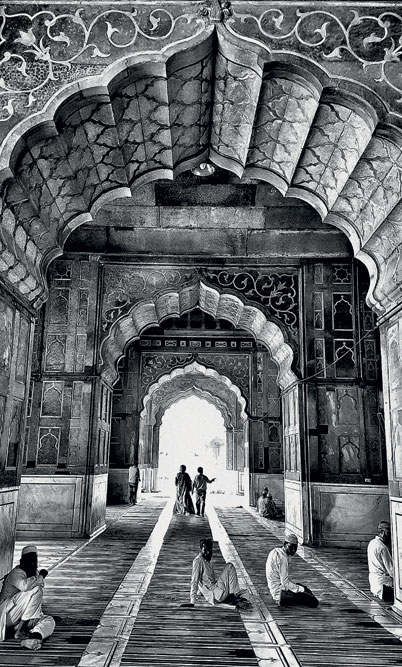
My Calcutta-born, part-Bengali great-great-aunt was Julia Margaret Cameron, one of the first women photographers and among the greatest artists of the 19th century. A force of nature, she would waylay anyone, and rarely took no for an answer. In order to illustrate Tennyson’s Idylls of the King, Victorian politicians such as Gladstone and Disraeli, as well as Tennyson, Watts, Darwin and the great artists and writers of early Victorian London, would be removed from her lunch parties and draped in rugs and tinsel crowns and made to pose as King Arthur, while their wives, servant girls and stray passersby, willing and unwilling, would be dressed up as Queen Guenevere or the Lady of the Lake.
Julia Margaret ended up retiring to Sri Lanka where she created a tea plantation at Dimbola, above Nuwara Eliya. Her last photographs are portraits of the plantation Tamils who worked around her in her old age. As a child in Scotland, I used to leaf through her portraits in the albums we had at home and envy the world she had created and her ability to make such luminous and painterly portraits with a camera.
If Cartier-Bresson were alive today, I feel he would definitely be using a cellphone camera. It has everything that he loved
I have taken photographs since I was first given a tiny Kodak for my seventh birthday, but when I was 15 I was left some money by a relation and spent it on a fabulous Contax 35mm SLR with a pin-sharp Carl Zeiss T* lens. For the next five years I spent much of my time in the school dark room, emerging after several hours stinking of fixer, with waterlogged hands, and developer splashed all over my clothes, but clutching a precious sheaf of 10 by 8 prints.
I always preferred black-and-white, partly because it allowed me to develop and edit my own prints; but mainly because black-and-white seemed a much more daring and exciting world, full of artistic possibilities. ‘Black,’ wrote Matisse—a man who knew something about colour—‘is a force,’ and I have always believed that black-and-white has a visceral power that colour can never match.
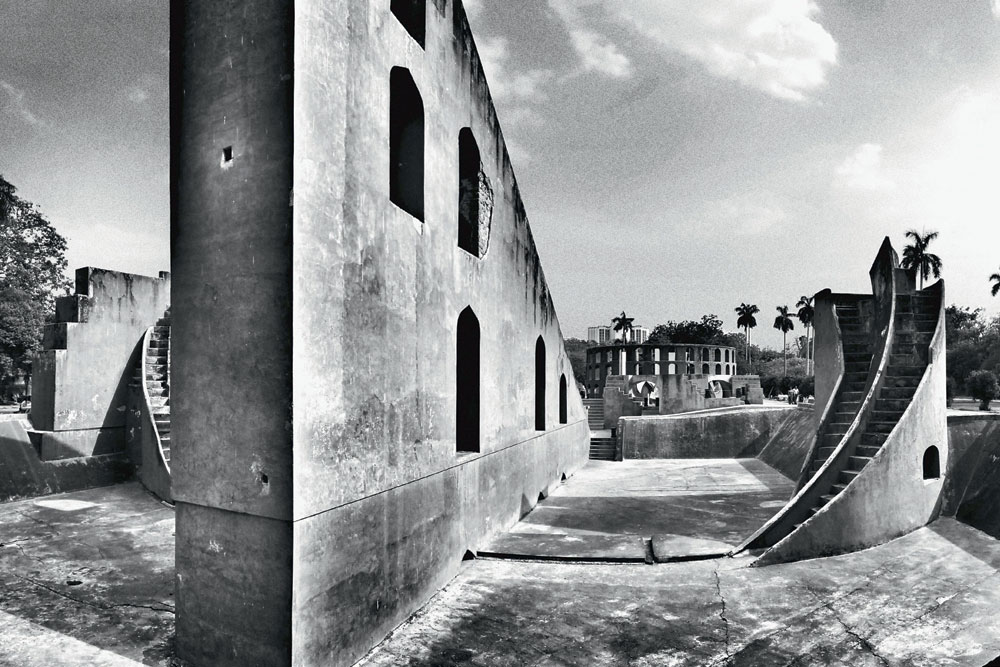
As a teenager, I spent a lot of time leafing through photographic books and particularly admired the bleak and grainy war photography of Don McCullin and the landscape work of Fay Godwin. But my real hero was Bill Brandt, whose quiet, darkly brooding images were marked by a stark chiaroscuro, a strongly geometrical sense of composition, a whiff of the surreal and a taste for the uncanny and unsettling.
Inspired by Brandt, I always tried to push my prints to make them as gritty as possible, and used to prefer grainy HP5 film, and high-contrast papers. Dodging and cropping, burning and using collage, I attempted to mirror Brandt’s anthracite skies and velvety jet black landscapes, trying to capture the same bleakness that he was able to read into the hills and towns he captured on film. Like him, I was drawn to the austere, the elemental, the pared down: a rock, a tree, a solitary figure in a landscape. In time, I won a couple of regional and then national young photographer awards.
In time, however, writing took over from photography as my artistic outlet, and my precious Contax came to languish unused in its bag. It is only in the last couple of years, since I jettisoned my last Blackberry for a Samsung Edge, that I have rediscovered my passion for photography. I now have an excellent little camera tucked away permanently in my back pocket. Discovering Snapseed edit suite has allowed me to produce the sort of grainy black-and-white images I love best for the first time in 25 years. And these days, advances in technology mean that I can produce this work without covering myself with chemicals.
Like Bill Brandt, I was drawn to the austere, the elemental, the pared down: A rock, a tree, a solitary figure in a landscape
Being a photographer involves a diametrically different set of skills to those of a writer. When a writer and a photographer look at a landscape, they don’t see the same thing. A writer imposes his imagination with a memory of the past associated with that place. The photographer sees what’s in front for what it is, because that’s what is in the viewfinder. Moreover, you engage a very different part of your brain when you act visually and capture something with the lens rather than the pen. As a writer, you work and rework your prose, you polish and polish again like a Mauryan sculptor polishing a yakshi, as you patiently try to cut your sentences down to their essence. Photography in contrast is a far more immediate and feline art form: often your best images are those that capture the fleeting moment. You whip out your camera and you seize something that may vanish in a second. It’s impulsive, instinctive, intuitive and non-intellectual, often done without forethought or planning. The best such images have the sudden, instant perfection of a cat’s flawless all-four-paws landing.
The primary inspiration has been my historical travels, and this collection is a record of a restless couple of years, researching between Shah Alam’s Delhi and the Company’s Calcutta. One particularly fruitful trip was to Calcutta during Durga Puja—the great annual festival of the city in honour of the great goddess who is worshipped on this occasion as a symbol of familial love. I watched statues of the goddess be sculpted from mud and straw by specialist idol makers, then brought into worship for a week, before finally being immersed in the Ganges. “It breaks my heart to take this wonderful statue to the river and drop it in,” said Abhoy Bhattacharjee, who was organising one of the pujas. “It is a moment beyond tears. Durga is our mother. The very day after the immersion we begin counting again until the next Durga Puja.”
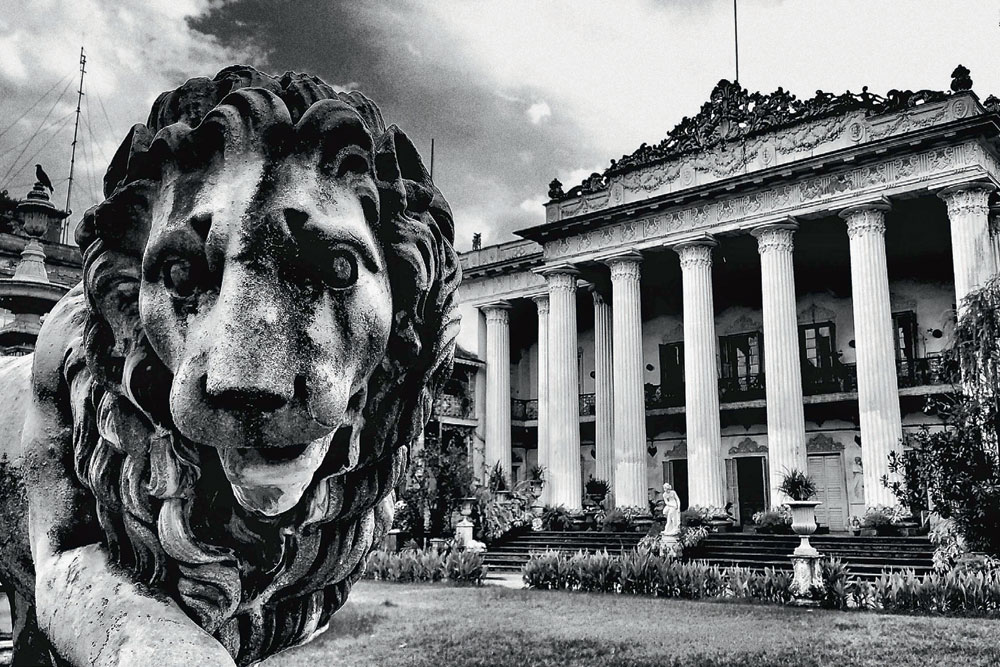
On this trip, I also went to rediscover some of my lost Bengali roots—the bit of my DNA that directly connects me with the world of 18th-century India. Over the course of the Durga Puja week, I toured what remained of the graves, monuments and houses and palaces that my ancestors must have known, ranging from the great Marble Palace of the Mullick family in North Calcutta, through the National Library, once the centre of the administration of Warren Hastings, to South Park Street Cemetery, St John’s Church where my great-grandfather was baptised, and the crumbling mansions of Garden Reach where he was brought up. Both worlds came together when I saw images of the goddess immersed at Prinsep Ghat. This is named after my Orientalist great-uncle, James Prinsep, who in the early 19th century unlocked the secrets of Kharosthi and Asoka Brahmi, the script of the Asoka Pillars, so rediscovering a whole new chapter of forgotten ancient Indian history. The effort cost him his life: he developed ‘an affectation of the brain’, and by the time he was bundled aboard the Herefordshire to be sent home, ‘his mind was addled.’
On the wall of St John’s Church there I found a memorial to my favourite forbear and Julia Margaret Cameron’s father, James Pattle, my great-great-grandfather. Pattle became famous as ‘the biggest liar in India’ after he allegedly claimed to have rowed across the Atlantic in a hen coop. According to the memoir of another of his great-grandchildren, Virginia Woolf—who also shares my trickle of Bengali blood—Pattle eventually drank himself to death and was put in a casket of rum to preserve him during the voyage back to England. His wife had the cask placed outside her bedroom door. In the middle of the night there was a violent explosion, and when the widow rushed out into the passage, she found the container had burst with her husband half in, half out of the barrel. ‘The shock sent her off her head then and there, poor thing, and she died raving…’ But the worst was yet to come. The cask was nailed down and put on board ship.
Sometime after the boat had set off, the sailors guessed it was full of liquor, bored a hole into the side of it and began to get drunk. The rum continued to run out, caught fire and set the ship ablaze. While the drunken sailors were trying to extinguish the flames, the ship ran onto a rock and blew up. So it was that Pattle was cremated rather than buried in Britain, as he had wished.
Other photographs in this collection come from a journey along the Ganges looking for ittar in Kannauj, searching for fragments of the world of the Nawabs in the latticed half light of the chowks of Lucknow, and exploring the crumbling Paigah palaces of old Hyderabad. Some of the most fruitful hunting grounds were summer walks through the valleys of Kashmir—both the half of the country within the Indian Line of Control, and those parts of the old Kashmir state lost to Pakistan in 1947.
Srinagar was especially fascinating, a strange mixture of heaven and hell. In the morning, the window of my houseboat on the Nigeen Lake would be open, and as I lay in bed I could see the reed cutters and fishermen form a perfect willow-pattern through the wooden frame of the houseboat windows: the shikara canoes would be in the foreground; behind were the bridges and waterways, the willows and the poplars, and the orchards of apricots and almonds. There were children paddling in the shallows, and girls carrying brushwood bundles on their heads. Beyond stretched the old Mughal water-gardens, and above them, the mulberry trees of the silk farmers. Crowning all this were the jagged snow-peaks of the great Himalayas.
BUT THEN, AFTER breakfast, I would get out my notebook, and drive into the old city of Srinagar. There I would find myself in a much more dangerous and volatile world. Curfew was on. Sometimes the only signs of life were the dogs rooting around in the rubbish and the paramilitary police, the CRPF, spaced out at intervals along the streets. Everything was closed up behind the Hansel-and-Gretel fretwork shutters.
Other images emerged from treks in the Punjab hills looking for the places where Nainsukh and the other Pahari miniaturists produced some of the greatest paintings of 18th-century India. From Pathankot, the road rises rapidly through walled gardens and orchards of mangoes, until it reaches the wooded switchbacks that lead up to Jot Pass. It is the landscape you see in Pahari paintings: a panorama of terracing and white-spired temples, of looping rivers and rice paddy, of hilltop forts, purple jacaranda and shepherds grazing their flocks.
As you snake upwards, you find that the air is fresher, and the temperature cooler. Large hawks circle the thermals above the white boulders washed by headwaters of the Ravi. The road corkscrews up the slope, past clumps of wild rhododendron, until finally at the top of the pass you find yourself looking down on the green Chamba Valley framed against the white wall of the snow peaks. To one side is a sweep of tall green deodars; on the other, the white dragonsbacks of the hills. In between the two, the stone houses tumble down a steep mountainside, the high-pitched slate roofs alternating with roof terraces where the women are drying apricots and stacking kindling for the winter.
Beyond Chamba it is wild country: the only traffic you meet are groups of nomadic Gujjars on their summer migrations, driving their brindling flocks of sheep and goats and water buffaloes to graze on the new grass of the high pastures. As the road rises and crosses the treeline, the landscape becomes bleaker: you find yourself in a stark landscape of mist and rolling cloudbanks, mosses and lichens, scree slopes and gritstone cliffs.
Through all these travels, as with those that inspired The Writer’s Eye, I have carried my humble Samsung Edge mobile phone. I get a particular pleasure out of the immediacy and the lack of pretension inherent in using a cellphone to record the world around me. For photography should always be about the eye, not the equipment.
In the 1930s and 1940s the photographers I most admire, like Robert Capa or Henri Cartier-Bresson, always chose to shoot on a Leica because it was tiny and the noise of the shutter was almost inaudible. Leicas could be hidden within clothing and the lens only came out a couple of centimetres. They were effectively an extension of the eye, certainly compared to the large-format cameras everyone else was using in those days. The cellphone takes it a stage further. When you’re holding up your phone, even if you’re pointing it directly at someone, you could just be looking at your email. You can even fake it by pretending to tap out a message. In this way, you can capture a whole series of portraits of someone without them being aware. If Cartier-Bresson were alive today, I feel he would definitely be using a cellphone camera. It has everything that he loved: the invisibility, the lack of sound, the informality. It allows for that sensation of being the hunter, walking on tip-toe through the forest camouflaged. It is, in a sense, guerrilla photography.
Just as black-and-white has a greater intensity than colour, breaking down reality into an essence and emphasising pattern and signal over noise, using so simple an instrument as a cellphone raises vision over technique: you are not distracted by light metres, aperture settings or shutter speed; composition is all. I’m aware, of course, that I’m losing a lot using a cellphone. There are many things that you can do on a DSLR that you can’t do on a cellphone, particularly variable lenses—telephoto, wide angle, fisheye—and control over depth of field. What you gain with a cellphone is simplicity and the way you can concentrate on the image. Often when you are using a DSLR, you’re worrying about light and technique and you’re fiddling around with the dials on the top of your camera. There is a kind of liberation in not having to worry about that. You try to capture the moment, to see patterns in a landscape, tell stories in chance encounters, and create a measure of order out of random chaos. You try to stop for one millisecond the relentless trajectory of Time’s Arrow. Moreover, if the image is a success, no one can attribute it to fancy equipment.
In this way, in this set of images, I have attempted to commemorate the lost world of Shah Alam’s fading Mughal Empire. One of the last eyewitnesses to see the blind old man ruling from the Red Fort remarked how ‘the ravages of time are discernible on his face, and the recollections of his misfortunes have impressed his features with melancholy.’ The same melancholy, I think pervades the places he lived in, and this is what I have attempted to capture in these photographs: the very particular flavour, or rasa, of the long elegiac shadows thrown by the broken arches of the Mughal Twilight.
(The exhibition ‘The Historian’s Eye’ will run at Vadehra Art Gallery, Delhi, till October 31)
About The Author
MOst Popular
3

/wp-content/uploads/2025/07/Cover-Shubman-Gill-1.jpg)






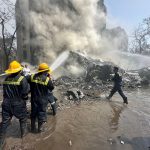



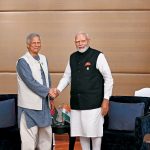

More Columns
Why India's Rich And Famous Choose To Settle Abroad Short Post
‘Fuel to Air India plane was cut off before crash’ Open
Shubhanshu Shukla Return Date Set For July 14 Open